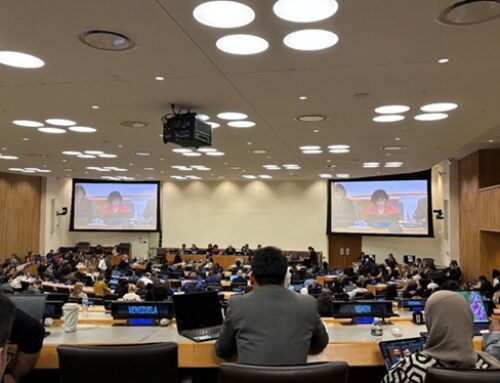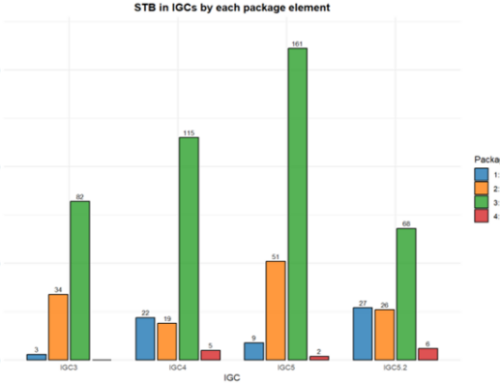As the Council of the International Seabed Authority (ISA) concluded Part I of the ISA’s 30th Session on Friday March 28, more questions than answers on the future of deep-sea mining remain. The two-week meeting in Kingston, Jamaica, saw intense negotiations on the draft mining regulations, discussions on whether commercial mining may start in the absence of rules and regulations, and the last- minute news that a mining company is threatening to circumvent the ISAs authority and commence commercial deep-sea mining unilaterally.
Written by Emil W. Hildebrand
Emil W. Hildebrand’s report on the first Council meeting of the International Seabed Authority’s 30th Session, March 17-28, 2025. Attended online as part of the TwinPolitics research project led by Alice Vadrot and funded by the European Research Council.

Negotiation venue at the ISA headquarters in Kingston, Jamaica.
The ISA is in the process of negotiating the ‘Mining Code’, a set of rules and regulations for the exploitation of mineral resources on the international seabed. Its mandate set by the United Nations Convention on the Law of the Sea (UNCLOS) and its 1994 Implementation Agreement, gives the ISA the monumental and often contradictory tasks of a) facilitating deep-sea mining; b) ensuring that activities benefits humankind as a whole both now and in the future; and c) protecting the marine environment from any harmful effects in the process.
As it stands, the negotiations are a tug-of-war between countries wanting to finalise the Mining Code and commencing commercial exploitation as soon as possible, and countries calling for a moratorium or cautioning against hasting the process, prioritizing robust regulations and strong environmental protection.
Exploitation without regulations?
This dynamic became especially apparent in the final day’s discussions on how the ISA should handle a mining application if it is submitted before the Mining Code is in place. The point was added to the agenda by Nauru, which has already announced that its sponsored contractor – Canadian mining company The Metals Company (TMC) – will hand in an application this summer. Nauru and TMC insist that the ISA is obliged to provisionally accept a mining contract in the absence of rules and regulations, as per the by now infamous “two-year rule” in the 1994 UNCLOS Implementation Agreement. In a move criticised by several Council members during the meeting, Nauru circulated its proposal for how this process should unfold only on the morning of the final day of the two-week long meeting, leaving the rest of the Council with minimal time to review its contents.
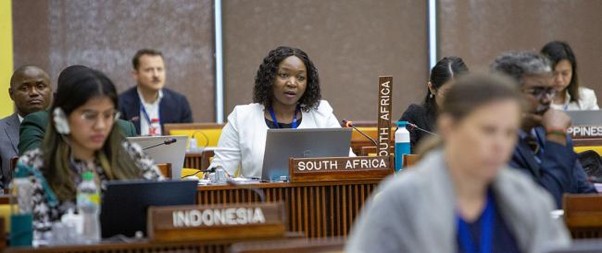
South African delegate Tshifhiwa Mabidi making a statement on behalf of the African Group
Naturally, Nauru’s proposal received strong pushback from the rest of the Council’s members. Even the agenda point itself became contentious, with Chile proposing an alternative title and Brazil calling for moving the whole discussion to the Council meeting in July. On the issue itself, a few pro-mining countries took the opportunity to call for a faster negotiation process, but not even traditionally supportive states like Russia, Japan, or China would endorse Nauru and TMC’s proposal, nor explicitly voice their support for mining in the absence of established rules and regulations.
Instead, an overwhelming majority took the floor to reiterate the Council’s own decisions from 2023, stating that no mining shall take place without a finished Mining Code (International Seabed Authority, 2023a, 2023b, 2023c). As South Africa, on behalf of the 48 members of the African Group, said:
Approving a plan of work in the absence of the complete legal and regulatory framework will effectively set aside the safeguards of the Convention and the Agreement, a most unfortunate and unacceptable outcome. Short-term commercial gains should not be prioritized over the long-term sustainability of the marine environment.
Finalizing the Mining Code remains a distant goal
After following the negotiations over the last two weeks, it is hard to imagine a finished Mining Code anytime soon.
This session was only the Council’s second reading of a full draft text, and after two weeks and 55 of 107 regulations covered, more divergence than consensus seems to remain. The brackets are still many and reaching consensus will take a lot more work. As Portugal reminded the Council on Wednesday 19th: “Nothing is agreed until everything is agreed”. That being said, some progress was made during the discussions. A notable example was a joint proposal made by Belgium, Germany, and China on test and pilot mining (International Seabed Authority, 2025), which received much support from the floor and was commended for its compromise-seeking nature.
At the same time, states disagreed over essentials such as the application of a possible mining code. The Netherlands, for example, questioned whether the draft text should apply to all three resource types found in the Area or just the most common polymetallic nodules. The issue was echoed by several delegations during the two weeks of negotiations, but never properly discussed. That the scope of the whole text is still up for debate should give a hint as to how much remains to be agreed upon.

Hydroid in the Corymorphidae family captured at a depth of 2,563 meters.
Add to this a long and contentious list of standards and guidelines that need to be in place before any commercial mining takes place, Regional Environmental Management Plans for each region of exploitation, a whole financial payment and benefit-sharing regime, and the establishment of environmental thresholds, just to name a few, and it is clear to see that the ISA has its work cut out for it. Each provision is both technically difficult and politically controversial.
Squaring the Circle: Fundamental challenges for the ISA and the Mining Code
The process of developing a Standard for environmental thresholds is emblematic of a set of fundamental challenges haunting the ISA. Thresholds will determine the limits for how much impact any mining activity may have on the environment and are a key component of the Mining Code. As Costa Rica put it during the Council meeting:
The importance of thresholds is immense. In fact, the entire exploitation regime depends on thresholds being clearly set […] These are the thresholds that will determine whether a contract is awarded, they will be the most important measure in order to effectively protect the seabed.
Being a technical and scientific endeavour, the task of developing thresholds was given to the scientific and legal experts at the ISA’s Legal and Technical Commission (LTC). At the Council meeting, delegations made sure to thank the LTC for its work so far, but many raised concerns with low participation rates, closed-door meetings, and lack of transparency in the process of consulting with external experts. In addition, LTC members work on a voluntary basis, and have over the course of the last few years gotten ever more tasks, including reviewing applications, controlling contractor activities, gathering data and reports from exploration contracts, and developing standards and guidelines for the Mining Code.
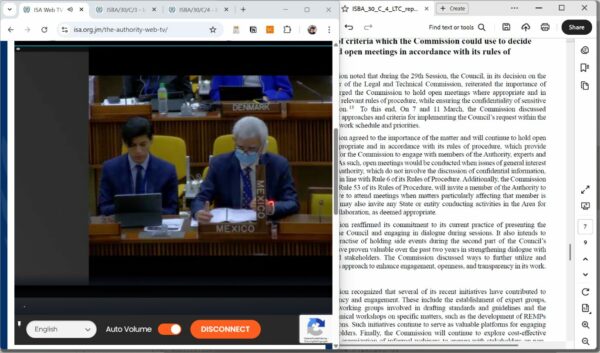
Following the negotiations online via ISA Web TV. On the right is the Report of the Chair of the Legal and Technical Commission, which was discussed by the Council on Thursday March 27.
Intransparency, underfunding, and lack of capacity are concerns that have been raised before, not just for the LTC, but for the whole ISA (Ardron, 2018; Lipton, 2022). The election of new Secretary General Leticia Reis de Carvalho, who raised transparency as one of her focus points in an opening statement given on the meeting’s first day, may prove to be a turning point for the Authority, but listening to the many calls for greater transparency made by delegations during these weeks’ negotiations makes it apparent that much work remains.
Thresholds also showcase the complex interplay between science and politics. For while they are scientific in their formulation, thresholds are inherently political in their nature. The scope, applicability, development, and function of thresholds within the broader deep-sea mining regime is a question that needs to be answered politically, leading to a ping-pong dynamic between political bodies like the Council and Assembly, technical-political bodies like the LTC, and external scientific experts.
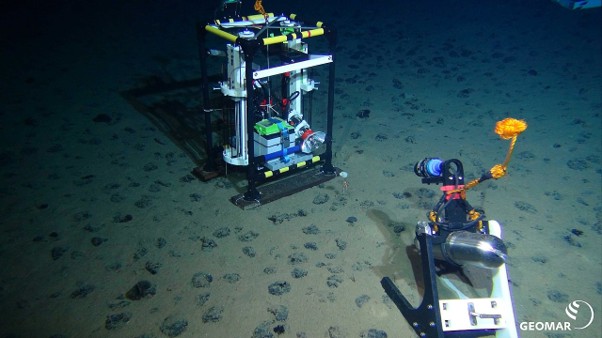
Photo from a scientific mission in the Clarion Clipperton Zone. Polymetallic nodules can be seen spread across the seabed
These difficulties also relate to the issue that looms large over the whole negotiation process: The lack of scientific knowledge about the deep sea, which both country delegations and observers emphasized during the negotiations. A mining regime in line with UNCLOS is obliged to effectively protect the marine environment. Ensuring such protection, however, is extremely challenging, if not impossible, without a better knowledge base for the environment to be protected. Data collection in areas of interest for deep-sea mining has increased in recent years, but, as an observer from the Deep Sea Conservation Coalition stated on the first day: “the continual groundbreaking science emerging from the depths shows just how little we actually know”. It is not without reason that some call the deep sea humanity’s “final frontier” (Kirkham et al., 2020).
In light of these knowledge gaps, the group of countries calling for a moratorium on deep-sea mining has continued to grow, currently counting 32 states. Most ask for a precautionary pause until more is known about the deep sea and the potential impacts of mining activities. The list includes countries that have previously shown interest in commercial exploitation, such as the UK and Mexico. France, whose national institute for ocean science and technology (IFREMER) currently holds two exploration contracts in the Clarion Clipperton Zone, is the only country so far in support of an outright ban.
These fundamental debates over a moratorium, precautionary pause, or ban are expected to come up during the Assembly meeting in July.
Last-minute drama: TMC USA’s bid for unilateral action
On the last day of the meeting, The Metals Company took the spotlight once again after announcing on its website that it intends to apply for a mining contract under US law. In this dramatic twist to the story, TMC and the US would bypass UNCLOS and pursue deep-sea mining in international waters unilaterally – circumventing the ISA’s (and thereby UNCLOS’) authority completely.
The strategic timing of the announcement looks like a bid to pressure the ISA to finish the Mining Code quicker or to provisionally approve the Nauru-TMC contract due in July. It is questionable, however, if this worked in TMC’s favour. After the Secretary General brought up the issue at the beginning of Friday’s meeting, Council members and observers took to the floor one after another to criticise the move and unanimously voice their support for multilateralism and international law. The debate about provisionally accepting a mining contract followed directly after, and as previously mentioned resulted in a strong opposition to allowing any mining in the absence of rules and regulations.
While the Council’s criticism of the U.S. for sidelining international law was clearly and unanimously expressed, only two delegations touched on what this might mean for the relationship between TMC and the ISA. In addition to the Nauru-sponsored contract, TMC holds another contract for the Clarion Clipperton Zone with the small island state of Tonga. Costa Rica criticised the active role TMC has taken in trying to shape the negotiation process and pointed to the company’s continuous presence at the negotiation site in Kingston. Uganda made a short but pointed statement, hinting that TMC’s US application could be a breach of their good-faith obligation under their contract with the ISA. The question also remains how the same company can mine under both US and ISA law in the same area in the future – as Greenpeace pointed out, TMC’s own information to investors included reassurances that a finished ISA Mining Code would not impact their mining activities under US law.
This issue is sure to resurface when TMC and Nauru hands in their application this summer, and the ISA’s relationship with TMC will likely come under even closer scrutiny.
What’s next?
The hurdles are many and, frankly, sometimes seemingly insurmountable, on the road to a finished Mining Code. While watching countries discuss the wording choices and granular technical details of the draft regulations, it is easy to forget just how much controversy surrounds deep-sea mining, how much country positions diverge, and how many provisions must be finalised before mining can commence. Questions remain on a potential moratorium or ban on deep-sea mining, and likely on the Assembly agenda in summer will be the question of developing a general environmental policy for the ISA – a provision so far blocked by a small number of member states but, if adopted, could set further environmental restrictions on the development of a deep-sea mining regime.
The Council will convene again for two weeks in July to finish their second reading of the draft regulations, followed by a one-week meeting of the Assembly. As part of the TwinPolitics research project, I will be on-site in Jamaica to report on the developments as they unfold, in what is set to be an eventful summer in the world of deep-sea mining.
Further reading:
TwinPolitics was also on site for the Global Plastics Treaty in Busan, South Korea in November 2024!
Read Felix Nütz’ report here: To the article
References
Ardron, J. A. (2018). Transparency in the operations of the International Seabed Authority: An initial assessment. Marine Policy, 95, 324–331. https://doi.org/10.1016/j.marpol.2016.06.027
International Seabed Authority. (2023a). Decision of the Council of the International Seabed Authority on a timeline following the expiration of the two-year period pursuant to section 1, paragraph 15, of the annex to the Agreement relating to the Implementation of Part XI of the United Nations Convention on the Law of the Sea (No. ISBA/28/C/24). https://www.isa.org.jm/documents/isba-28-c-24/
International Seabed Authority. (2023b). Decision of the Council of the International Seabed Authority relating to the understanding and application of section 1, paragraph 15, of the annex to the Agreement relating to the Implementation of Part XI of the United Nations Convention on the Law of the Sea (1) (No. ISBA/28/C/9). https://www.isa.org.jm/documents/isba-28-c-9/
International Seabed Authority. (2023c). Decision of the Council of the International Seabed Authority relating to the understanding and application of section 1, paragraph 15, of the annex to the Agreement relating to the Implementation of Part XI of the United Nations Convention on the Law of the Sea (2) (No. ISBA/28/C/25). https://www.isa.org.jm/documents/isba-28-c-25/
International Seabed Authority. (2025). Joint proposal by Belgium, China and Germany on Test Mining. https://www.isa.org.jm/wp-content/uploads/2025/03/Joint-proposal-by-Germany-Belgium-and-China_final.pdf
Kirkham, N. R., Gjerde, K. M., & Wilson, A. M. W. (2020). DEEP-SEA mining: Policy options to preserve the last frontier – Lessons from Antarctica’s mineral resource convention. Marine Policy, 115, 103859. https://doi.org/10.1016/j.marpol.2020.103859
Lipton, E. (2022, August 29). Secret Data, Tiny Islands and a Quest for Treasure on the Ocean Floor. The New York Times. https://www.nytimes.com/2022/08/29/world/deep-sea-mining.html



